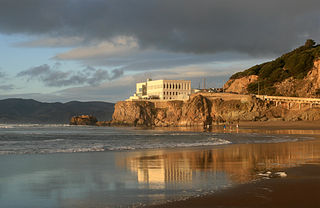
Ocean Beach is a beach on the west coast of San Francisco, California, United States, bordering the Pacific Ocean. It is adjacent to Golden Gate Park, the Richmond District, and the Sunset District. The Great Highway runs alongside the beach, and the Cliff House and the site of the former Sutro Baths sit at the northern end. The beach is a part of the Golden Gate National Recreation Area, which is administered by the National Park Service.

Playland, often called Rye Playland and also known as Playland Amusement Park, is an amusement park located in Rye, New York, along the Long Island Sound. Built in 1928, the 280-acre (110 ha) park is owned by the Westchester County government. Beginning with the 2018 season, Standard Amusements LLC has been contracted to operate the park.

The Santa Cruz Beach Boardwalk is an oceanfront amusement park in Santa Cruz, California. Founded in 1907, it is California's oldest surviving amusement park and one of the few seaside parks on the West Coast of the United States.
A family entertainment center, often abbreviated FEC in the entertainment industry also known as an indoor amusement park, family amusement center, family fun center, or simply fun center, is a small amusement park marketed towards families with small children to teenagers, often entirely indoors. They usually cater to "sub-regional markets of larger metropolitan areas." FECs are generally small compared to full-scale amusement parks, with fewer attractions, a lower per-person per-hour cost to consumers than a traditional amusement park, and not usually major tourist attractions, but sustained by an area customer base. Many are locally owned and operated, although there are a number of chains and franchises in the field. Some, operated by non-profit organizations as children's museum or science museums, tend to be geared toward edutainment experiences rather than simply amusement.

A funhouse or fun house is an amusement facility found on amusement park and funfair midways where patrons encounter and interact with various devices designed to surprise, challenge, and amuse them. Unlike thrill rides or dark rides, funhouses are participatory attractions, where visitors enter and move around under their own power. Incorporating aspects of a playful obstacle course, they seek to distort conventional perceptions and startle people with unstable and unpredictable physical circumstances within an atmosphere of wacky whimsicality.
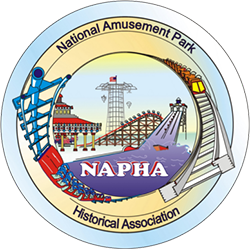
The National Amusement Park Historical Association (NAPHA) is an international organization dedicated to the preservation and enjoyment of the amusement and theme park industry – past, present and future.

The Musée Mécanique is a for-profit interactive museum of 20th-century penny arcade games and artifacts, located at Fisherman's Wharf in San Francisco, California. With over 300 mechanical machines, it is one of the world's largest privately owned collections.

The Pinball Hall of Fame is a museum for pinball machines that opened in Las Vegas, Nevada in November 2009. It is located at 4925 S. Las Vegas Boulevard. The museum is a project of the Las Vegas Pinball Collectors Club, and it features pinball machines from all eras, including some very rare machines such as Williams' Black Gold, Bally's Pinball Circus and Recreativos Franco's Impacto. It features nearly 700 different pinball games, including some classic video arcade games and other novelty machines of the past and present.
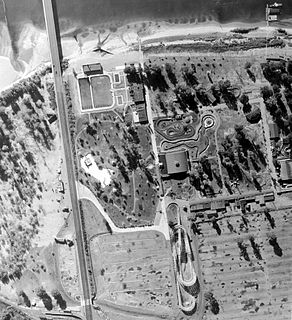
Jantzen Beach Amusement Park was a popular amusement park from 1928 to 1970 in Portland, Oregon, on Hayden Island in the middle of the Columbia River. "The Coney Island of the West" opened on May 26, 1928 as the largest amusement park in the nation, covering over 123 acres (50 ha) at the northern tip of Portland.
Fascination is a game commonly found in North American amusement parks, boardwalks and arcades. The game would be considered in the same family as skee ball, in that prizes are often won for playing the game. The game dates to the 1920s as evidenced in pictures of Chutes at the Beach in San Francisco, a park that operated from 1903 - 1928.
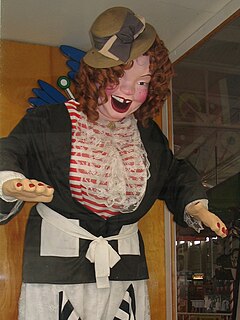
Laffing Sal is one of several animatronic characters that were built primarily to attract carnival and amusement park patrons to funhouses and dark rides throughout the United States. Its movements were accompanied by a raucous laugh that sometimes frightened small children and annoyed adults.

Midway State Park, located in Maple Springs, New York, was established in 1898 by the Jamestown & Lake Erie Railway as a picnic ground. Today, it is recognized as the fifteenth-oldest continually operating amusement park in the United States, and the fifth-oldest remaining trolley park of the thirteen still operating in the United States.

The Allan Herschell Company specialized in the creation of amusement rides, particularly carousels and roller coasters. The company manufactured portable machines that could be used by traveling carnival operators. It was started in 1915 in the town of North Tonawanda, just outside Buffalo, New York, USA.

Playland was a 10-acre (40,000 m2) seaside amusement park located next to Ocean Beach, in the Richmond District at the western edge of San Francisco, California along Great Highway where Cabrillo and Balboa streets are now. It began as a collection of amusement rides and concessions in the late 19th century and was known as Chutes at the Beach as early as 1913. It closed Labor Day weekend in 1972.
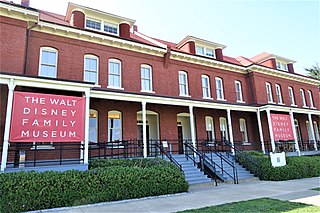
The Walt Disney Family Museum (WDFM) is an American museum that features the life and legacy of Walt Disney. The museum is located in The Presidio of San Francisco, part of the Golden Gate National Recreation Area in San Francisco. The museum retrofitted and expanded three existing historic buildings on the Presidio’s Main Post. The principal building, at 104 Montgomery Street, faces the Parade Ground, and opened on October 1, 2009.

Galaxi is the common name of a series of mass-produced roller coasters manufactured primarily by Italian company S.D.C, which went bankrupt in 1993. The roller coaster design was first used in the 1970s, and as of 2009, sixteen Galaxi coasters are still in park-based operation, across the North American, European, and Australian continents, with another two "Standing But Not Operating". At least 37 amusement parks are or have previously operated Galaxi coasters; this does not include those owned by funfairs and traveling ride companies.
The Marcks Family Miniature Circus is a miniature representation of the Sells Floto Circus of the 1930s. It was conceived and originated by Isaac Marcks and hand carved over the span of 50 years by him and his son Donald Marcks, publisher of the popular weekly publication Circus Report.

Funspot Family Entertainment Center is an arcade which features one of the largest collections of late-1970s to mid-1980s games in the world. It is located in the village of Weirs Beach in Laconia, New Hampshire, United States. Founded in 1952 by Bob Lawton, Funspot includes over 500 video games, pinball machines, and ticket redemption machines; an indoor miniature golf course; 20-lane ten-pin and candlepin bowling; cash bingo; a restaurant; a tavern; and several other attractions on its grounds.
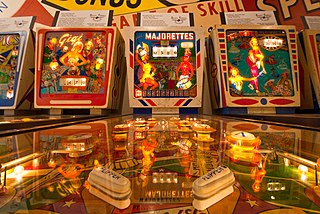
The Pacific Pinball Museum is a Board Managed and certified 501 C(3) nonprofit interactive museum/arcade offering a chronological and historical selection of rare bagatelles and early pinball games in addition to over 90 playable pinball machines ranging in era from the 1940s to present day located on Webster Street in Alameda, CA.
















